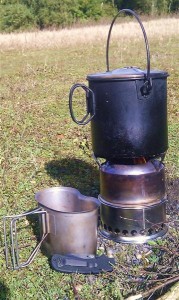I had been thinking about how we impact on the world around us while practising our outdoor skills. We go into the outdoors to enjoy the natural world and it makes sense for us to minimise our impact on our surroundings while we are there. At the same time we still want to enjoy the certain things – crafting items from the materials we find around us and enjoying the wonders of the open fire and all that goes with it (the smell of the woodsmoke, the flickering flames, the moral boosting warmth and its versatility for cooking).
Our fire however, consumes large amounts of wood and can scar the ground. I’m sure we are all very careful to cover the traces of our fires and to only use the dead wood lying around on the woodland floor.
If we use a site on a regular basis then our woodlands resources can quickly dwindle without careful management, at Forgewood we use a fire-pan made from an old gas cylinder (fuelled by off-cuts from spoons and locally produced, sustainable charcoal) to keep our “brew-fire” going.
But what about when we are on the trail? We often visit the wilder areas of the UK, where these resources are at a premium and don’t want to leave any trace of our passing in these places of great beauty. Most people resort more conventional gas, multi-fuel or meths type stoves when travelling in wilderness areas. But even this has an impact in the form extra erosion because of the added weight that we are carrying.
I had often looked at some of the portable woodstoves on the market and thought what a great idea, the likes of the Bush-Buddy stoves and the one with a small electric fan in the base really appealed as I only had to carry my stove – the fuel could be gathered on the trail. The problem I found with these were they are expensive and not that easy to obtain.
A client of mine on a trip to Scotland, brought a Honey Stove along, which I was very impressed with. For our week in north-west Highlands virtually all his cooking was done on the stove and he fuelled with pine cones he picked up as he went along. This was the answer!
Then earlier this year I saw a new UK based company – Wildstoves (www.wildstoves.co.uk) based in Devon. This little company sells a range of woodburning stoves and related items.
One item that caught my eye was the Wild Woodgass Stove Mk2. This stove is aimed at the backpacking/bushcraft market, costs less than £50 and weighs in at 280gms. I purchased one and have used it throughout the summer, so its had a fairly good test ( I know it works well in the wet!). It is easy to use, very efficient (with the right fuel) and leaves nothing more than a small pile of very fine white ash no bigger than the palm of your hand.
Certainly for the £50 I think it was money well spent, and while not quite as fast as its more high-tec counterparts – it has a nice simplicity, and its nice to smell the woodsmoke and watch the flames flicker.

